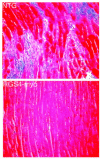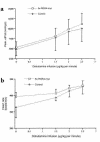RGS4 causes increased mortality and reduced cardiac hypertrophy in response to pressure overload
- PMID: 10487771
- PMCID: PMC408537
- DOI: 10.1172/JCI6713
RGS4 causes increased mortality and reduced cardiac hypertrophy in response to pressure overload
Abstract
RGS family members are GTPase-activating proteins (GAPs) for heterotrimeric G proteins. There is evidence that altered RGS gene expression may contribute to the pathogenesis of cardiac hypertrophy and failure. We investigated the ability of RGS4 to modulate cardiac physiology using a transgenic mouse model. Overexpression of RGS4 in postnatal ventricular tissue did not affect cardiac morphology or basal cardiac function, but markedly compromised the ability of the heart to adapt to transverse aortic constriction (TAC). In contrast to wild-type mice, the transgenic animals developed significantly reduced ventricular hypertrophy in response to pressure overload and also did not exhibit induction of the cardiac "fetal" gene program. TAC of the transgenic mice caused a rapid decompensation in most animals characterized by left ventricular dilatation, depressed systolic function, and increased postoperative mortality when compared with nontransgenic littermates. These results implicate RGS proteins as a crucial component of the signaling pathway involved in both the cardiac response to acute ventricular pressure overload and the cardiac hypertrophic program.
Figures










Similar articles
-
Genetic enhancement of ventricular contractility protects against pressure-overload-induced cardiac dysfunction.J Mol Cell Cardiol. 2004 Nov;37(5):979-87. doi: 10.1016/j.yjmcc.2004.07.010. J Mol Cell Cardiol. 2004. PMID: 15522275
-
Substrain specific response to cardiac pressure overload in C57BL/6 mice.Am J Physiol Heart Circ Physiol. 2013 Aug 1;305(3):H397-402. doi: 10.1152/ajpheart.00088.2013. Epub 2013 May 24. Am J Physiol Heart Circ Physiol. 2013. PMID: 23709599 Free PMC article.
-
Basigin Promotes Cardiac Fibrosis and Failure in Response to Chronic Pressure Overload in Mice.Arterioscler Thromb Vasc Biol. 2016 Apr;36(4):636-46. doi: 10.1161/ATVBAHA.115.306686. Epub 2016 Feb 25. Arterioscler Thromb Vasc Biol. 2016. PMID: 26916734
-
Induction and analysis of cardiac hypertrophy in transgenic animal models.Methods Mol Med. 2005;112:339-52. doi: 10.1385/1-59259-879-x:339. Methods Mol Med. 2005. PMID: 16010028 Review.
-
Developmental Aspects of Cardiac Adaptation to Increased Workload.J Cardiovasc Dev Dis. 2023 May 10;10(5):205. doi: 10.3390/jcdd10050205. J Cardiovasc Dev Dis. 2023. PMID: 37233172 Free PMC article. Review.
Cited by
-
SLIT3 deficiency attenuates pressure overload-induced cardiac fibrosis and remodeling.JCI Insight. 2020 Jun 18;5(12):e136852. doi: 10.1172/jci.insight.136852. JCI Insight. 2020. PMID: 32644051 Free PMC article.
-
Autonomic Nervous System Regulation of Epicardial Adipose Tissue: Potential Roles for Regulator of G Protein Signaling-4.Curr Issues Mol Biol. 2022 Dec 5;44(12):6093-6103. doi: 10.3390/cimb44120415. Curr Issues Mol Biol. 2022. PMID: 36547076 Free PMC article. Review.
-
Cardiomyocyte-specific deficiency of ketone body metabolism promotes accelerated pathological remodeling.Mol Metab. 2014 Aug 13;3(7):754-69. doi: 10.1016/j.molmet.2014.07.010. eCollection 2014 Oct. Mol Metab. 2014. PMID: 25353003 Free PMC article.
-
The critical role of Astragalus polysaccharides for the improvement of PPARα [ correction of PPRAα]-mediated lipotoxicity in diabetic cardiomyopathy.PLoS One. 2012;7(10):e45541. doi: 10.1371/journal.pone.0045541. Epub 2012 Oct 1. PLoS One. 2012. PMID: 23049681 Free PMC article.
-
Sphingosine-1-phosphate and endothelin-1 induce the expression of rgs16 protein in cardiac myocytes by transcriptional activation of the rgs16 gene.Naunyn Schmiedebergs Arch Pharmacol. 2008 Jan;376(5):363-73. doi: 10.1007/s00210-007-0214-2. Epub 2007 Nov 29. Naunyn Schmiedebergs Arch Pharmacol. 2008. PMID: 18046543
References
-
- Sadoshima J, Izumo S. The cellular and molecular response of cardiac myocytes to mechanical stress. Annu Rev Physiol. 1997;59:551–571. - PubMed
-
- Knowlton KU, et al. Co-regulation of the atrial natriuretic factor and cardiac myosin light chain-2 genes during α-adrenergic stimulation of neonatal rat ventricular cells. J Biol Chem. 1991;266:7759–7768. - PubMed
-
- Lee H, et al. α1-adrenergic stimulation of cardiac gene transcription in neonatal rat myocardial cells: effects on myosin light chain-2 gene expression. J Biol Chem. 1988;263:7352–7358. - PubMed
Publication types
MeSH terms
Substances
LinkOut - more resources
Full Text Sources
Other Literature Sources
Molecular Biology Databases

